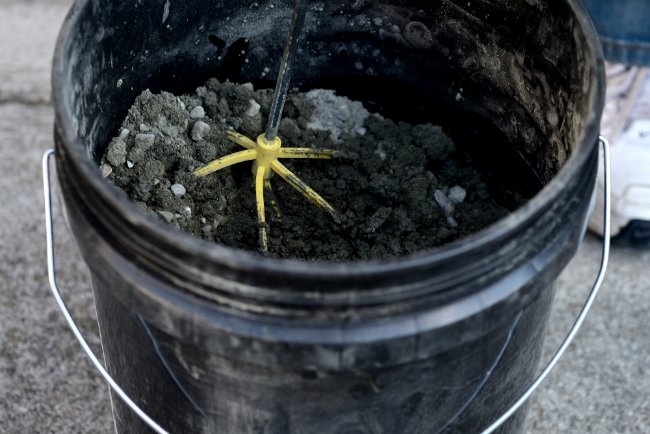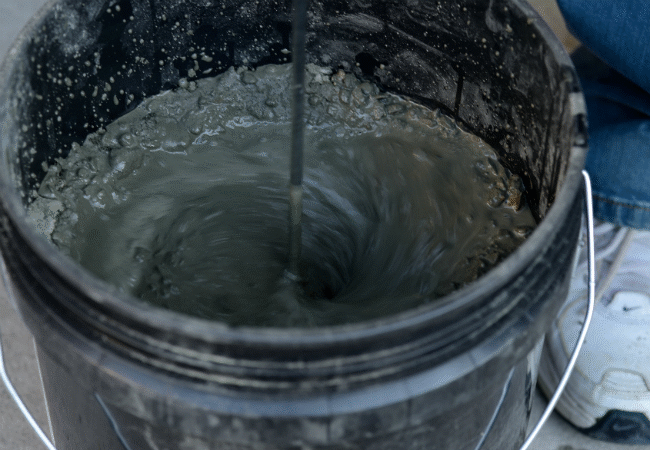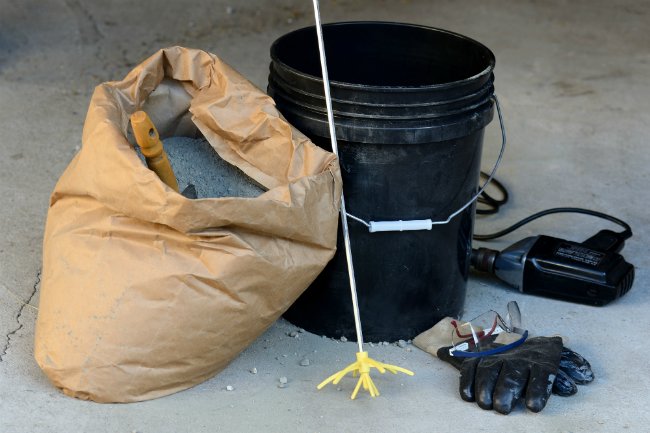We may earn revenue from the products available on this page and participate in affiliate programs. Learn More ›
Concrete holds a place of honor in both the professional construction and do-it-yourself worlds. When mixed correctly, this simple combination of aggregate, cement, and water becomes strong and durable enough to produce walkways, beautiful planters, walls, and even house foundations. While concrete trucks with perpetually rotating drums deliver mixed concrete for large jobs, DIY concrete projects typically operate on a smaller scale, relying on dry sack concrete mixed with water. The secret to a successful project lies in mixing the concrete correctly and knowing which tools to use. Sure, the old standbys—a wheelbarrow and hoe—are still adequate choices for mixing all-purpose concrete if you don’t have access to a portable power mixer. But when it comes to wet-cast concrete, which is rapidly growing in popularity as a material for countertops and other castings, an impressive new tool promises to speed up the job: the HYDE StirWhip. To ensure satisfying results, read on to find out what you should (and shouldn’t) do with this trusty tool when you’re mixing concrete.

DO gather all the materials and supplies you’ll need before starting.
Before you begin, run through your checklist one last time. You won’t want to have to dig out a missing item once your hands are covered in wet concrete. At the top of your list will be the dry concrete mix and a water source. The tools you’ll need for mixing will depend on your choice of concrete:
• Because the all-purpose concrete used in larger projects like sidewalks, slabs, or paver patios is quite thick and heavy—and there will be a lot of it—it’s a good idea to work with a sturdy wheelbarrow (one that won’t tip over under the weight) and a hoe. Or, consider upgrading to a portable concrete mixer, which you can rent from a big-box home improvement center for around $50 a day.
• To make countertops, balusters, or other small concrete accents with smoother finishes, you’ll want to whip up a wet-set concrete mix that consists of smaller bits of aggregate. Mix this in a large plastic bucket using a fully charged power drill and the under-$10 StirWhip drill attachment. Because the StirWhip features an 18-inch-long, 3/8-inch-thick steel shank (unlike shorter mixing paddles), you can reach all the way to the bottom of a five-gallon bucket with ease so you won’t leave any dry powder unmixed. The attachment’s multi-finger configuration helps reduce drag on your drill while slicing quickly through the mix for a smooth blend. Plus, those open fingers are easy to clean of wet or dried concrete when the job is done.
DON’T skip the protective eyewear, rubber gloves, long sleeves, and pants.
Concrete splatters can burn eyes and irritate bare skin by quickly drawing out its moisture, leaving it rough, dry, and cracked. Take steps to protect yourself by donning the appropriate gear.
DO know exactly how much concrete you need.
By calculating ahead of time the amount of concrete your project requires—and adding 10 percent to ensure that you don’t run short—you’ll avoid “cold joints,” which occur when part of your project dries before you can mix and add the concrete needed to finish a project. Not only will you probably notice a visual difference between the first and second batches of concrete, but those cold joints will be weak spots where the concrete is more likely to break later. (For reference: A standard 80-pound bag yields 0.60 cubic feet of concrete, while a 60-pound bag yields 0.45 cubic feet, and a 40-pound bag yields 0.30 cubic ft.)

DON’T just dump the dry concrete mix in first.
This may come as a surprise to you if you’ve ever mixed concrete in a wheelbarrow, where you do add water to a heap of dry concrete mix. The wheelbarrow’s shape necessitates adding the mix first—the shallow sloped sides of a wheelbarrow make it too easy for water to slosh out when mix is thrown on top. But that’s not a hard-and-fast rule for mixing all concrete. When you’re working in a bucket, you’ll want to put the water in first (and you can do so without fear of losing any) in order to keep the dry concrete mix from sticking to the bottom of the bucket and making it difficult to blend. Once you’ve filled the bucket with the amount of water recommended by the concrete manufacturer, gradually trowel in the dry mix until you’re ready to blend it with your drill and HYDE StirWhip attachment.
DON’T leave any water puddles or dry bits in the concrete mixture.
In order to set correctly, the water and the dry concrete ingredients must be thoroughly combined. A good rule of thumb: Continue mixing with a hoe or blending with a StirWhip for three minutes after you no longer see any pockets of mix that are still dry or water pooling at the top. Otherwise, you could end up with undermixed concrete that once cured could be weak and prone to crumbling and cracking.

DO test for “slump” before beginning your project.
Concrete consistency is determined by “slump,” or how much the wet concrete settles after it’s been formed into a cone shape. To test the slump on your fresh batch, you can use a professional slump cone (available from home improvement stores) or a reasonable DIY facsimile made from a sturdy plastic cup with its bottom cut off. Dampen the inside of the cone, and place it so that its larger end is on a flat, nonporous surface. Then, fill the cone through its open top with thoroughly mixed concrete, tamping it down with your hands or (if the hole is too narrow) a rod as you go. When you lift the cone away, the wet concrete should slump to about half its original height if it is all-purpose concrete or one-third of its original height if it’s a more fluid, wet-set mix. If the slump is less than it should be, churn a little more water into the batch; a larger slump than expected requires additional dry mix. Test again before casting your project, and to ensure uniformity and strength in the finished product, don’t move on until the mix has reached a desirable consistency.
And now, armed with some practical info—and a new tool—you’re ready to make your concrete dreams come true!
This content has been brought to you by Hyde Tools. Its facts and opinions are those of BobVila.com.


